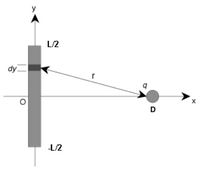A charge Q=7.3×10−4 C is distributed uniformly along a rod of length L, extending from =−28.8/2 cm to =+28.8/2 cm, as shown in the diagram below. A charge q=4.15×10−6 C, and the same sign as Q , is placed at (D,0), where D=55 cm.
Consider the situation as described above and the following statements.
Check each box that corresponds to a true statement. Select "None of the above" if none of them are true.
A. The total force on q is generally in the +x direction.
B. The charge on a segment of the rod of infinitesimal length dy is given by dQ=(Q/L)dy
C. The y-components of the force on q cancel.
D. The magnitude of the force on charge q due to the small segment dy is dF=(kqQ/4Lr2)dy
E. Given that both charges are positive, the net force on q in the y direction is upwards.
F. Given that both charges are positive, the net force on q in the x direction is to the left.
G. None of the above.

Trending nowThis is a popular solution!
Step by stepSolved in 9 steps

- The figure below shows four small spheres, each with a positive charge, at the corners of a square. The length of each side of the square is a. The sphere at top-right has a charge of q; the one at lower-left has a charge of 7.0g, the other two each have a charge of 2.5g. (Assume that the +x-axis is to the right and the +y-axis is up along the page.) 2.59 7.0g 2.5g (a) What is the magnitude of the force on the sphere with charge q? Express your answer in terms of ke. q, and a in symbolic form. F = (b) What is the direction of the force on the sphere with charge q? (Enter your answer in degrees counterclockwise from the +x-axis.) 1 counterclockwise from the +x-axisarrow_forwardPlease help me in thisarrow_forwardA particle of mass 7.25 x 10-9 kg is moving 14.5 m/s in a field of 0.0393 T. It moves in a circle of radius 0.100 m. What is the charge of the particle? [?]×10?'C Coefficient (green) Exponent (yellow) Enterarrow_forward
- Please help me with the following and make sure its correct 100%, explain, thanks Q: A charge of -2.65 nCnC is placed at the origin of an xy��-coordinate system, and a charge of 1.90 nCnC is placed on the y� axis at y� = 4.20 cmcm . part A. If a third charge, of 5.00 nCnC , is now placed at the point x� = 3.15 cmcm , y� = 4.20 cmcm find the x� and y� components of the total force exerted on this charge by the other two charges. Enter your answers in newtons separated by a comma. Part B. Find the magnitude of this force. Express your answer in newtons. Part C. Find the direction of this force. Express your answer in degrees. (clockwise from the +x+� axis) more info. check the picturesarrow_forwardSubpart D please, thank you Charged particles are floating in the following configuration in space. The particle in position 1 has a charge of 1.3x10-6C, and is located 55mm West ofposition 2. The particle in position 3 has a charge of -2.8x10-6C, and is located63mm East of position 2. The particle in position 4 has a charge of 3.1x10-6C, and is located 33mmSouth of location 2. d.Determine the total electric potential energy of the group of charges.arrow_forwardYou Answered Correct Answer A line of charge is placed along the negative x axis from x=-0.4m to x=0. The charge is uniformly distributed with linear charge density 3.06pC/m. A proton is released from rest at a point on the positive x axis 2.53m. When the proton has a speed of 472.1m/s, how far will it have moved (in m}? 1.0975 margin of error +/-1%arrow_forward
- In the question above, charge q 2 is 2x10 -9C and charge q 1 has mass 0.23g. The separation r is 2.5cm, and the angle θ is 15.9 degrees. Find q 1(magnitude and sign, you don't need to enter a + for positive answers but you will need to enter a - if negative). Note: the answer for this question is very small and using scientific notation will help. This system uses E in place of x10 so for example to enter 3x10 -24 type 3E-24 in the answer box.arrow_forwardA square is 53.0 cm on a side. (Assume that the +x-axis is to the right and the +y-axis is up along the page) Find the total Coulomb force on the charge q in the figure below, given that q = +1.25 µC, qa = +2.25 µC, qb = −3.05 µC, qc = −4.10 µC, and qd = +1.25 µC. The answer should list both magnitude (in N) and direction (in degrees counterclockwise from the +x-axis)arrow_forward